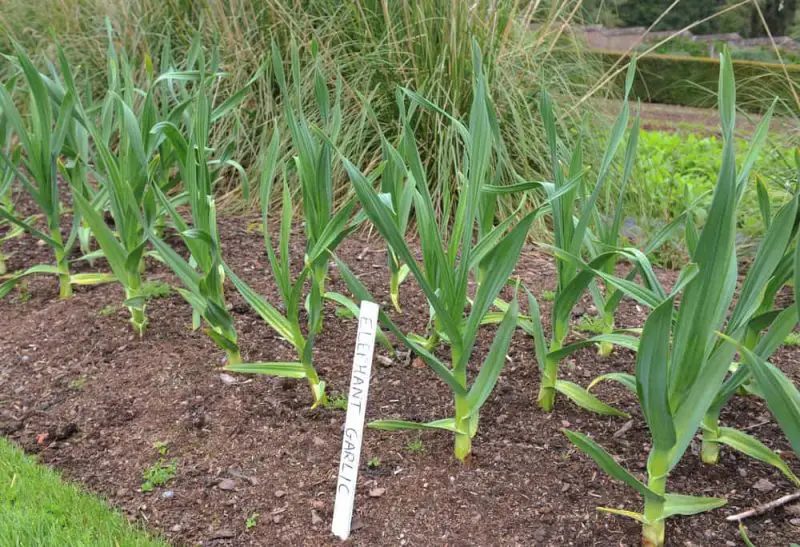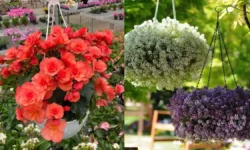Elephant garlic is a unique and fascinating plant that stands apart from common garlic varieties due to its large size and milder flavor. Although it is called “garlic,” elephant garlic (Allium ampeloprasum) is more closely related to leeks than to true garlic. However, it forms large cloves similar in appearance to garlic and is prized by gardeners for its impressive bulbs and culinary versatility. Understanding the best time to harvest elephant garlic is crucial for achieving the highest quality yield and flavor.
Growing elephant garlic is a rewarding endeavor for both beginner and experienced gardeners. The plant requires a long growing season and specific environmental conditions to thrive. It typically takes about 8 to 9 months from planting to harvest. Knowing exactly when to harvest elephant garlic can make the difference between a robust, flavorful bulb and one that’s underdeveloped or past its prime.
In this comprehensive guide, we will explore everything you need to know about the ideal timing for harvesting elephant garlic to ensure the best results.
Table of Contents
Understanding the Elephant Garlic Growth Cycle

Elephant garlic follows a lengthy but well-defined growth cycle that closely resembles other members of the Allium family. It is generally planted in the fall, allowing the bulbs to establish roots before the cold winter months. As spring arrives, the plant begins to grow rapidly, producing tall green stalks and broad, flat leaves. By mid to late spring, some plants may even produce a flowering stalk, although this is more common in second-year or overwintered plants.
During the early stages of growth, elephant garlic focuses on establishing a strong root system and foliage. This phase is critical because healthy leaves are necessary for photosynthesis, which supports bulb development later in the season. As the plant progresses through spring and into early summer, it begins allocating more energy to the formation of the underground bulb. The timing and extent of this transformation depend on several factors including soil quality, weather conditions, and the health of the plant.
By mid to late summer, the elephant garlic bulb reaches maturity. This stage is marked by a slowdown in foliage growth and visible signs that the plant is nearing the end of its life cycle. Recognizing these signs is essential to harvesting the garlic at its peak. Pulling the garlic too early can result in small, immature cloves, while waiting too long can lead to split bulbs or mold issues if the plant experiences wet conditions.
Recognizing the Signs of Maturity
One of the most reliable indicators that elephant garlic is ready to harvest is the state of its leaves. As the plant matures, the green leaves begin to yellow and die back, starting from the bottom and working upward. When about one-third to one-half of the leaves have turned yellow or brown, it’s generally a sign that the bulb has reached optimal size and maturity. At this point, the plant is still receiving enough energy from the remaining green leaves to complete bulb development while signaling that the growth cycle is nearly complete.
Another important cue is the feel of the soil around the base of the plant. Mature elephant garlic will often rise slightly in the soil, making the top of the bulb just barely visible at the surface. You can gently dig around the base to check the size of the bulb without disturbing the roots too much. If the cloves are well-formed and tightly wrapped in their papery skins, the garlic is likely ready to be pulled.
The presence or absence of a flowering stalk can also provide clues. If the plant has sent up a scape—the thick central stalk that carries the flower head—this should be removed earlier in the season to encourage better bulb growth. However, if a scape has formed and is allowed to mature, it may indicate that the plant is transitioning into the final stage of its life cycle. Bulbs harvested shortly after flowering tend to be at or near full maturity, though timing is still crucial to avoid overripening.
Ideal Harvest Timing Based on Climate
Climate plays a significant role in determining the precise harvest time for elephant garlic. In temperate regions with mild winters and warm summers, elephant garlic planted in the fall is usually ready to harvest in late June through early August. In colder northern climates, the growing season may be slightly shorter, shifting the harvest window to mid or late July. In warmer southern areas, especially those with mild winters, harvesting can begin as early as late May depending on the planting date.
It’s important to track the seasonal progress of your specific growing zone and observe your garden conditions. Keep a journal or record of when the garlic was planted and monitor how quickly it develops in spring. Regular visual inspections and soil checks will help you narrow down the best time to dig up the bulbs. Timing may vary slightly from year to year based on rainfall, temperature fluctuations, and other environmental factors.
Gardeners in areas with excessive summer rainfall should be particularly vigilant. Moist conditions near the end of the growing cycle can lead to rot or fungal issues. In such climates, it may be better to harvest a few days earlier once the leaves begin to show signs of yellowing. Dry weather during the final two weeks of growth is ideal for developing a firm, well-cured bulb that stores well after harvest.
Harvesting Techniques for Best Results
When the signs of maturity align and you’re confident the bulbs are ready, it’s time to harvest carefully to avoid damage. Use a garden fork or spade to gently loosen the soil around the base of the plant. Avoid pulling the stalks directly, as this can cause them to snap or detach from the bulb. Insert the tool a few inches away from the stem and lift the bulb out with the surrounding soil intact.
Once removed from the ground, gently shake off excess dirt but avoid washing the bulbs at this stage. The skins are still delicate and excess moisture can lead to mold or decay during the curing process. Instead, set the garlic in a shaded, well-ventilated location with good airflow. Garages, covered porches, or open sheds work well for curing as long as they remain dry.
Allow the garlic to cure for about two to three weeks. During this time, the outer skins will dry and harden, helping to protect the cloves inside. The stalks and roots should also be allowed to dry fully before trimming. Once curing is complete, you can cut the stalks about an inch above the bulb and trim the roots. Store the finished garlic in a cool, dry place out of direct sunlight to extend its shelf life.
Common Mistakes to Avoid During Harvest
Harvesting elephant garlic might seem straightforward, but several common mistakes can reduce the quality and longevity of your bulbs. One of the most frequent issues is harvesting too early. When pulled prematurely, bulbs may be small and underdeveloped, with loose skins and poor flavor. These bulbs often don’t store well and may sprout quickly.
Waiting too long to harvest can also cause problems. Overripe bulbs may split in the ground, exposing the cloves to soil and moisture. This increases the risk of rot, especially in rainy conditions. Split bulbs are also more prone to insect damage and are harder to cure and store. The ideal harvest window is narrow, so regular monitoring is essential.
Another issue is rough handling during harvest. Bruised or cut bulbs are more likely to develop mold or spoilage during storage. Always use gentle techniques and handle bulbs by the stalks whenever possible. Finally, poor curing conditions—such as high humidity, lack of airflow, or direct sun exposure—can compromise the final quality of your harvest. Choose a shaded, breezy area and allow enough time for a thorough cure before trimming and storing the garlic.
What to Do After Harvest
Once your elephant garlic has cured and been properly trimmed, there are several options for using and storing your crop. The cloves can be used fresh in recipes or preserved for later use. Elephant garlic’s mild, slightly sweet flavor makes it ideal for roasting, grilling, or slicing raw into salads and dishes. It also pairs well with butter, herbs, and vegetables.
Store bulbs in mesh bags, crates, or open baskets that allow air circulation. Avoid plastic containers, as they trap moisture and encourage spoilage. The optimal storage location is a cool, dark, and dry area such as a pantry, basement, or cellar. Under these conditions, cured elephant garlic can last several months without sprouting or softening.
For gardeners interested in growing elephant garlic again, some of the largest and healthiest bulbs can be saved for replanting. Choose firm, intact cloves and store them in ideal conditions until fall planting season. Over time, replanting your own stock can result in larger, more vigorous bulbs adapted to your garden’s unique conditions.
FAQs About When to Harvest Elephant Garlic
What month do you harvest elephant garlic?
Elephant garlic is typically harvested between late June and early August, depending on your climate and when it was planted.
How do I know when elephant garlic is ready to harvest?
It’s ready when one-third to half of the leaves have yellowed and the bulbs feel firm and well-developed under the soil.
Can you harvest elephant garlic too early?
Yes, harvesting too early can result in small, underdeveloped bulbs with poor flavor and shorter storage life.
Should I let elephant garlic flower before harvesting?
It’s best to remove the flower stalk early to encourage better bulb growth, though flowering is a sign the plant is maturing.
How long should elephant garlic cure after harvesting?
Let it cure in a dry, shaded, and well-ventilated space for 2–3 weeks before trimming and storing.
Conclusion: Timing Is Everything for a Successful Harvest
The key to harvesting elephant garlic for best results lies in observing the plant’s natural signals and responding with care and precision. From planting in the fall to curing in the summer heat, every stage of the growth cycle contributes to the final outcome. Recognizing yellowing leaves, monitoring soil and weather conditions, and harvesting at just the right moment all play critical roles in determining your success.
When properly timed, elephant garlic offers a high reward for your patience—enormous bulbs, delicious flavor, and impressive storage life. Whether you’re a seasoned grower or trying it for the first time, understanding the nuances of when to harvest elephant garlic will ensure you get the most from every bulb. With attention to detail and a little practice, you can enjoy a bountiful crop year after year that truly stands out in your garden and your kitchen.






